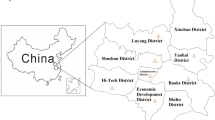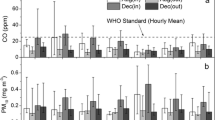Abstract
Gasoline evaporation and spills may cause high air pollution at gas stations. This study aimed to assess exposure to volatile organic compounds (VOCs) at gas stations among customers. Ambient air samples were collected in the fuel dispensing area of 51 gas stations in the Greater Memphis Area, USA, in summer 2017. For the comparison purpose, samples were collected in the ambient air at 20 community sites and in the indoor air of 30 homes, 11 offices, and 15 running vehicles in the same region. Air sampling used Tenax TA thermal desorption (TD) tubes and samples were analyzed by TD-gas chromatography/mass spectrometry (GC/MS) for 70 target compounds. Gasoline-related VOCs were identified using factor analysis, and exposure at gas stations was evaluated using Monte Carlo analysis. Benzene, toluene, ethylbenzene, and xylenes (BTEX) showed the highest concentrations ranging from 2 to 15 μg/m3, ten times higher than those in the community air. Factor analysis confirmed gasoline as the common source of aromatic compounds. VOC concentrations had no association with the number of cars present or environmental parameters. Exposure to aromatic compounds at gas stations represented 2% of the total exposure (i.e., the sum of indoor and outdoor exposures) but 38% of the outdoor exposure among customers. The exposure levels were below the acute health thresholds and presented 0.3 × 10−6 lifetime excess cancer risk. In conclusion, customers’ exposure to VOCs at gas stations has negligible non-cancer and cancer risks. It is also suggested that customers stand away from the nozzle to avoid high personal exposures during refueling.


Similar content being viewed by others
Data availability
The datasets generated during and/or analyzed during the current study are available from the corresponding author on reasonable request.
References
Aguilera I, Guxens M, Garcia-Esteban R, Corbella T, Nieuwenhuijsen MJ, Foradada CM, Sunyer J (2009) Association between GIS-based exposure to urban air pollution during pregnancy and birth weight in the INMA Sabadell Cohort. Environ Health Perspect 117:1322–1327. https://doi.org/10.1289/ehp.0800256
Aguilera I, Pedersen M, Garcia-Esteban R, Ballester F, Basterrechea M, Esplugues A, Fernandez-Somoano A, Lertxundi A, Tardon A, Sunyer J (2013) Early-life exposure to outdoor air pollution and respiratory health, ear infections, and eczema in infants from the INMA Study. Environ Health Perspect 121:387–392. https://doi.org/10.1289/ehp.1205281
Amigou A, Sermage-Faure C, Orsi L, Leverger G, Baruchel A, Bertrand Y, Nelken B, Robert A, Michel G, Margueritte G, Perel Y, Mechinaud F, Bordigoni P, Hemon D, Clavel J (2011) Road traffic and childhood leukemia: The ESCALE Study (SFCE). Environ Health Perspect 119:566–572. https://doi.org/10.1289/ehp.1002429
ATSDR (2020) Minimal Risk Levels (MRLs) for Hazardous Substances. http://www.atsdr.cdc.gov/mrls/mrllist.asp Accessed 9/28 2018
Ayres BR, Allen HM, Draper DC, Brown SS, Wild RJ, Jimenez JL, Day DA, Campuzano-Jost P, Hu W, de Gouw J, Koss A, Cohen RC, Duffey KC, Romer P, Baumann K, Edgerton E, Takahama S, Thornton JA, Lee BH, Lopez-Hilfiker FD, Mohr C, Wennberg PO, Nguyen TB, Teng A, Goldstein AH, Olson K, Fry JL (2015) Organic nitrate aerosol formation via NO3+ biogenic volatile organic compounds in the southeastern United States. Atmos Chem Phys 15:13377–13392. https://doi.org/10.5194/acp-15-13377-2015
Batterman S, Jia C, Hatzivasilis G (2007) Migration of volatile organic compounds from attached garages to residences: a major exposure source. Environ Res 104:224–240. https://doi.org/10.1016/j.envres.2007.01.008
Batterman SA, Peng C-Y, Braun J (2002) Levels and composition of volatile organic compounds on commuting routes in Detroit, Michigan. Atmos Environ 36:6015–6030. https://doi.org/10.1016/S1352-2310(02)00770-7
Batterman SA, Yu YD, Jia CR, Godwin C (2005) Non-methane hydrocarbon emissions from vehicle fuel caps. Atmos Environ 39:1855–1867. https://doi.org/10.1016/j.atmosenv.2004.12.002
Bolden AL, Kwiatkowski CF, Colborn T (2015) New look at BTEX: are ambient levels a problem? Environ Sci Technol 49:5261–5276. https://doi.org/10.1021/es505316f
Boyd CM, Sanchez J, Xu L, Eugene AJ, Nah T, Tuet WY, Guzman MI, Ng NL (2015) Secondary organic aerosol formation from the beta-pinene+NO3 system: effect of humidity and peroxy radical fate. Atmos Chem Phys 15:7497–7522. https://doi.org/10.5194/acp-15-7497-2015
Branis M, Kolomaznikova J (2010) Year-long continuous personal exposure to PM2.5 recorded by a fast responding portable nephelometer. Atmos Environ 44:2865–2872. https://doi.org/10.1016/J.Atmosenv.2010.04.050
Byun HM, Panni T, Motta V, Hou LF, Nordio F, Apostoli P, Bertazzi PA, Baccarelli AA (2013) Effects of airborne pollutants on mitochondrial DNA Methylation. Part Fibre Toxicol 10:8. https://doi.org/10.1186/1743-8977-10-18
Ceballos D, Zielinska B, Fujita E, Sagebiel J (2007) Characterization of solid-phase microextraction and gas chromatography for the analysis of gasoline tracers in different microenvironments. J Air Waste Manag Assoc 57:355–365. https://doi.org/10.1080/10473289.2007.10465330
de Blas M, Navazo M, Alonso L, Durana N, Iza J (2013) Trichloroethylene, tetrachloroethylene and carbon tetrachloride in an urban atmosphere: mixing ratios and temporal patterns. Int J Environ Anal Chem 93:228–244. https://doi.org/10.1080/03067319.2011.629346
Delfino RJ, Gong H, Linn WS, Pellizzari ED, Hu Y (2003) Asthma symptoms in Hispanic children and daily ambient exposures to toxic and criteria air pollutants. Environ Health Perspect 111:647–656. https://doi.org/10.1289/ehp.5992
Edokpolo B, Yu QJ, Connell D (2014) Health risk assessment of ambient air concentrations of benzene, toluene and xylene (BTX) in service station environments. Int J Environ Res Public Health 11:6354–6374. https://doi.org/10.3390/ijerph110606354
Egeghy PP, Tornero-Velez R, Rappaport SM (2000) Environmental and biological monitoring of benzene during self-service automobile refueling. Environ Health Perspect 108:1195–1202. https://doi.org/10.2307/3434833
Ekpenyong CE, Asuquo AE (2017) Recent advances in occupational and environmental health hazards of workers exposed to gasoline compounds. Int J Occup Med Environ Health 30:1–26. https://doi.org/10.13075/ijomeh.1896.00800
Esteve-Turrillas FA, Pastor A, de la Guardia M (2007) Assessing air quality inside vehicles and at filling stations by monitoring benzene, toluene, ethylbenzene and xylenes with the use of semipermeable devices. Anal Chim Acta 593:108–116. https://doi.org/10.1016/j.aca.2007.04.055
Faraji A, Nabibidhend G, Pardakhti A (2017) Risk assessment of exposure to released BTEX in district 12 of Tehran municipality for employees or shopkeepers and gas station customers. Pollution 3:407–415. https://doi.org/10.7508/pj.2017.03.006
Hazrati S, Rostami R, Fazlzadeh M, Pourfarzi F (2016) Benzene, toluene, ethylbenzene and xylene concentrations in atmospheric ambient air of gasoline and CNG refueling stations. Air Qual Atmos Health 9:403–409. https://doi.org/10.1007/s11869-015-0349-0
Helmig D, Muller J, Klein W (1989) Volatile organic substances in a forest atmosphere. Chemosphere 19:1399–1412
Hilpert M, Breysse PN (2014) Infiltration and evaporation of small hydrocarbon spills at gas stations. J Contam Hydrol 170:39–52. https://doi.org/10.1016/j.jconhyd.2014.08.004
Hilpert M, Mora BA, Ni J, Rule AM, Nachman KE (2015) Hydrocarbon release during fuel storage and transfer at gas stations: environmental and health effects. Current Environmental Health Reports 2:412–422. https://doi.org/10.1007/s40572-015-0074-8
Jia C, Batterman S (2010) A critical review of naphthalene sources and exposures relevant to indoor and outdoor air. Int J Environ Res Public Health 7:2903–2939. https://doi.org/10.3390/ijerph7072903
Jia C, Batterman S, Godwin C (2008a) VOCs in industrial, urban and suburban neighborhoods - Part 2: Factors affecting indoor and outdoor concentrations. Atmos Environ 42:2101–2116. https://doi.org/10.1016/j.atmosenv.2007.11.047
Jia C, Batterman S, Godwin C (2008b) VOCs in industrial, urban and suburban neighborhoods, Part 1: Indoor and outdoor concentrations, variation, and risk drivers. Atmos Environ 42:2083–2100. https://doi.org/10.1016/j.atmosenv.2007.11.055
Jia C, Fu X (2017) Diffusive uptake rates of volatile organic compounds on standard ATD tubes for environmental and workplace applications. Environments 4:87
Kwon J, Weisel CP, Turpin BJ (2006) Source proximity and outdoor-residential VOC concentrations: results from the RIOPA study. Environ Sci Technol 40:4074–4082. https://doi.org/10.1021/es051828u
Lemke LD, Lamerato LE, Xu XH, Booze JC, Reiners JJ, Raymond DM, Villeneuve PJ, Lavigne E, Larkin D, Krouse HJ (2014) Geospatial relationships of air pollution and acute asthma events across the Detroit-Windsor international border: Study design and preliminary results. J Expo Sci Environ Epidemiol 24:346–357. https://doi.org/10.1038/jes.2013.78
Logue JM, Small MJ, Stern D, Maranche J, Robinson AL (2010) Spatial variation in ambient air toxics concentrations and health risks between industrial-influenced, urban, and rural sites. J Air Waste Manag Assoc 60:271–286. https://doi.org/10.3155/1047-3289.60.3.271
Lupo PJ, Symanski E, Waller DK, Chan WY, Langlois PH, Canfield MA, Mitchell LE (2011) Maternal exposure to ambient levels of benzene and neural tube defects among offspring: Texas, 1999–2004. Environ Health Perspect 119:397–402. https://doi.org/10.1289/ehp.1002212
MacIntosh DL, Spengler JD (2000) Human exposure assessment. World Health Organization, Geneva
Maleknia SD, Bell TL, Adams MA (2007) PTR-MS analysis of reference and plant-emitted volatile organic compounds. Int J Mass Spectrom 262:203–210. https://doi.org/10.1016/j.ijms.2006.11.010
McGregor D (2006) Methyl tertiary-butyl ether: studies for potential human health hazards. Crit Rev Toxicol 36:319–358. https://doi.org/10.1080/10408440600569938
Moghadam SR, Afshari M, Ganjali A, Moosazadeh M (2020) Effect of occupational exposure to petrol and gasoline components on liver and renal biochemical parameters among gas station attendants, a review and meta-analysis. Rev Environ Health 35:517–530. https://doi.org/10.1515/reveh-2019-0107
Naggar AYE, Elkhateeb A, Altalhi TA, El Nady MM, Alhadhrami A, Ebiad MA, Salem AA, Elhardallou SB (2017) Hydrocarbon compositions and physicochemical characteristics for the determination of gasoline quality: an implication from gas chromatographic fingerprints. Energy Sources, Part A: Recovery, Utilization, and Environmental Effects:1–6. https://doi.org/10.1080/15567036.2017.1370515
Paustenbach DJ (2000) The practice of exposure assessment: a state-of-the-art review (Reprinted from Principles and Methods of Toxicology, 4th edition, 2001). J Toxicol Environ Health-Part B-Crit Rev 3:179–291. https://doi.org/10.1080/10937400050045264
Pramono A, Oppewal H (2021) Where to refuel: modeling on-the-way choice of convenience outlet. J Retail Consum Serv 61https://doi.org/10.1016/j.jretconser.2021.102572
Scheepers PTJ, de Werdt L, van Dael M, Anzion R, Vanoirbeek J, Duca RC, Creta M, Godderis L, Warnakulasuriya DTD, Devanarayana NM (2019) Assessment of exposure of gas station attendants in Sri Lanka to benzene, toluene and xylenes. Environmental Research 178https://doi.org/10.1016/j.envres.2019.108670
Shearston JA, Hilpert M (2020) Gasoline vapor emissions during vehicle refueling events in a vehicle fleet saturated with onboard refueling vapor recovery systems: need for an exposure assessment. Front Public Health 8:8. https://doi.org/10.3389/fpubh.2020.00018
Shinohara N, Okazaki Y, Mizukoshi A, Wakamatsu S (2019) Exposure to benzene, toluene, ethylbenzene, xylene, formaldehyde, and acetaldehyde in and around gas stations in Japan. Chemosphere 222:923–931. https://doi.org/10.1016/j.chemosphere.2019.01.166
Slama R, Thiebaugeorges O, Goua V, Aussel L, Sacco P, Bohet A, Forhan A, Ducot B, Annesi-Maesano I, Heinrich J, Magnin G, Schweitzer M, Kaminski M, Charles MA, Eden,, Mother Child Cohort Study G (2009) Maternal personal exposure to airborne benzene and intrauterine growth. Environmental Health Perspectives 117:1313–1321. https://doi.org/10.1289/ehp.0800465
Strum M, Scheffe R (2016) National review of ambient air toxics observations. J Air Waste Manag Assoc 66:120–133. https://doi.org/10.1080/10962247.2015.1076538
Swick D, Jaques A, Walker JC, Estreicher H (2014) Gasoline risk management: a compendium of regulations, standards, and industry practices. Regul Toxicol Pharmacol 70:S80–S92. https://doi.org/10.1016/j.yrtph.2014.06.022
USEPA (1997) Exposure factors handbook. U.S. Environmental Protection Agency, Washington, DC
USEPA (1999) Compendium Method TO-17, Determination of volatile organic compounds in ambient air using active sampling onto sorbent tubes. U.S. Environmental Protection Agency, Cincinnati, OH
USEPA (2006) AP 42, Fifth Edition Compilation of Air Pollutant Emissions Factors, Volume 1: Stationary Point and Area Sources, Chapter 5. U. S. Environmental Protection Agency, Research Triangle Park, NC
USEPA (2007) Control of hazardous air pollutants from mobile sources; Final Rule (40 CFR Parts 59, 80, 85, and 86). U.S. Environmental Protection Agency, Washington, D.C.
USEPA (2011) Exposure Factors Handbook: 2011 Edition. U.S. Environmental Protection Agency, Washington, DC
USEPA (2014) Risk Assessment Forum White Paper: probabilistic risk assessment methods and case studies (EPA/100/R-14/004). U.S. Environmental Protection Agency, Washington, D.C.
USEPA (2016a) Guidelines for Human Exposure Assessment. U.S. Environmental Protection Agency, Washington, D.C.
USEPA (2016b) Initial list of hazardous air pollutants with modifications. https://www.epa.gov/haps/initial-list-hazardous-air-pollutants-modifications#mods. Accessed 14 Apr 2020
USEPA (2018) Integrated risk information system. http://www.epa.gov/iris/ Accessed 10/01 2018
USEPA (2019) Technical overview of volatile organic compounds. https://www.epa.gov/indoor-air-quality-iaq/technical-overview-volatile-organic-compounds Accessed 04/14 2020
Vainiotalo S, Peltonen Y, Ruonakangas A, Pfaffli P (1999) Customer exposure to MTBE, TAME, C-6 alkyl methyl ethers, and benzene during gasoline refueling. Environ Health Perspect 107:133–140. https://doi.org/10.2307/3434370
Villeneuve PJ, Jerrett M, Su J, Burnett RT, Chen H, Brook J, Wheeler AJ, Cakmak S, Goldberg MS (2013) A cohort study of intra-urban variations in volatile organic compounds and mortality, Toronto, Canada. Environ Pollut 183:30–39. https://doi.org/10.1016/j.envpol.2012.12.022
von Ehrenstein OS, Heck JE, Park AS, Cockburn M, Escobedo L, Ritz B (2016) In utero and early-life exposure to ambient air toxics and childhood brain tumors: a population-based case-control study in California, USA. Environ Health Perspect 124:1093–1099. https://doi.org/10.1289/ehp.1408582
Walgraeve C, Demeestere K, Dewulf J, Van Huffel K, Van Langenhove H (2011) Diffusive sampling of 25 volatile organic compounds in indoor air: uptake rate determination and application in Flemish homes for the elderly. Atmos Environ 45:5828–5836. https://doi.org/10.1016/j.atmosenv.2011.07.007
Weather Underground (2021) Weather Underground: About Our Data. https://www.wunderground.com/about/data Accessed 10/27 2021
Weisel CP (2002) Assessing exposure to air toxics relative to asthma. Environ Health Perspect 110:527–537. https://doi.org/10.1289/ehp.02110s4527
Whitworth KW, Symanski E, Coker AL (2008) Childhood lymphohematopoietic cancer incidence and hazardous air pollutants in Southeast Texas, 1995–2004. Environ Health Perspect 116:1576–1580. https://doi.org/10.1289/ehp.11593
Zheng H, Kong SF, Xing XL, Mao Y, Hu TP, Ding Y, Li G, Liu DT, Li SL, Qi SH (2018) Monitoring of volatile organic compounds (VOCs) from an oil and gas station in northwest China for 1 year. Atmos Chem Phys 18:4567–4595. https://doi.org/10.5194/acp-18-4567-2018
Zielinska B, Fujita E, Ollison W, Campbell D, Sagebiel J (2012) Quantification of personal exposure concentrations to gasoline vehicle emissions in high-end exposure microenvironments: effects of fuel and season. J Air Waste Manag Assoc 62:1346–1357. https://doi.org/10.1080/10962247.2012.712605
Funding
This study was supported by a JPB Environmental Health Fellowship award granted by the JPB Foundation and managed by the Harvard T.H. Chan School of Public Health.
Author information
Authors and Affiliations
Corresponding author
Ethics declarations
Conflict of interest
The authors declare no competing interests.
Additional information
Publisher's Note
Springer Nature remains neutral with regard to jurisdictional claims in published maps and institutional affiliations.
Supplementary Information
Below is the link to the electronic supplementary material.
Rights and permissions
About this article
Cite this article
Jia, C., Fu, X., Chauhan, B. et al. Exposure to volatile organic compounds (VOCs) at gas stations: a probabilistic analysis. Air Qual Atmos Health 15, 465–477 (2022). https://doi.org/10.1007/s11869-021-01124-5
Received:
Accepted:
Published:
Issue Date:
DOI: https://doi.org/10.1007/s11869-021-01124-5




